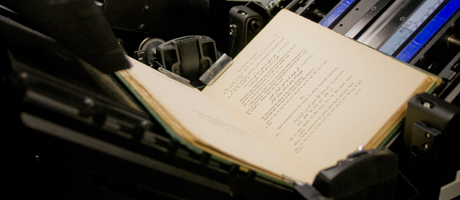By Menachem Wecker
The KABIS III automatic book digitizer looks like it could launch something back to the future if it hit 88 mph on the speedometer. But however unusual the unit appears, a recent demonstration of Gelman Library’s new digitizer showed how much it could impact the future of libraries, particularly for rare books or those in poor physical condition.
During the demonstration, representatives of Kirtas Technologies, which is partnering with GW and Georgetown University on a project called Cultural Imaginings, placed a late 19th-century copy of a translation of the Persian poetry collection Rubaiyat of Omar Khayyam on the KABIS III. The machine used a suction robotic arm to gently turn the pages, which it photographed automatically at a rate of 3,000 pages an hour in 400 dpi resolution.
Even a cursory look at the freshly printed copies of the Rubaiyat that came from the KABIS III showed the machine’s remarkable attention to detail. But the most important aspect might not appear on the printed book at all, according to Lotfi Belkhir, CEO of Kirtas.
The KABIS III captures all sorts of metadata that make the books searchable and accessible for repackaging for a variety of devices from Kindles to mobile devices. The KABIS III can also operate remotely, so someone could request a copy of a book in Gelman’s collection from another country, and Kirtas staff could use the metadata from the Foggy Bottom-based scan to transmit the file. The requesting party could have a printed book in hand without having to expend the financial and time investment of traveling to GW.
According to Martha Whittaker, head of technical services at Gelman, the project, which is partially funded by a grant from the Institute of Museum and Library Services (IMLS), has tremendous technological implications.
“I am often asked, ‘Isn’t Google already digitizing everything?’” she says. “In fact, we are not just digitizing and scanning, we are also doing OCR (optical character recognition) and producing very high-quality printing. You will never find a handprint in the middle of a KABIS III scan like you do with Google. This is true museum and library quality scanning.”
According to Ms. Whittaker, GW is the first university in the country to own a KABIS III. GW also purchased a Kirtas SkyView Flatbed Imaging System, which digitizes maps, large format books and artifacts that are too large or fragile to fit in the KABIS III.
The Kirtas equipment has many potential uses beyond the Cultural Imaginings project. GW is currently considering a non-exclusive contract to be part of Kirtasbooks.com, an online bookshop, which allows customers to request books to be printed on demand, Ms. Whittaker says. The books, like the copies of the Rubaiyat, retail for $10 apiece, and GW would get a royalty on any sales of books from its collection.
Of course, GW still has to comply with U.S. copyright laws, but most books published before 1923 are in the public domain. The University might also be permitted to scan a copyrighted book that is decaying and preserve a copy in a “dark archive” that is not accessible to the book borrowing community, Ms. Whittaker says.
As part of the Cultural Imaginings Project, GW is digitizing more than 2,500 monographic volumes and manuscripts from its collection of Middle East and North African books. While it is a valuable collection of materials, the real value is that GW has an opportunity to do full cost analysis of robotic scanning technology.
“The IMLS gives these grants for institutions to be leaders in evaluating the technology and the cost to see if this is the best technology to use,” says Ms. Whittaker. “The point of this project is to get some hard data on costs to inform the decisions of other institutions considering similar digitization projects.”
GW is “very pleased with the results so far,” she adds, and as part of the two-year grant which started October 1, 2009, GW’s and Georgetown’s report to the IMLS will be made public.
Regardless of what the findings are about the KABIS III, the new technology may prove particularly critical for digitizing one particular body of works, according to Brad Sabin Hill, curator of the Kiev Judaica Collection at Gelman.
Scientists only began to realize in the 1930s that the acid introduced in paper-making in the mid-19th century posed serious problems for conservation. Ironically, most books and periodicals printed on paper after 1850 are subject to decay, whereas the earlier non-acid paper is better preserved. The Hebraica holdings of the Kiev Collection fall into both categories, says Mr. Hill.
In that sense, the cutting-edge technology might be most helpful for digitizing and preserving not the oldest or newest books, but the pre-modern ones right in between.
Comments? Criticism? The conversation continues. We welcome reactions, commentary and story recommendations on our Facebook page.


